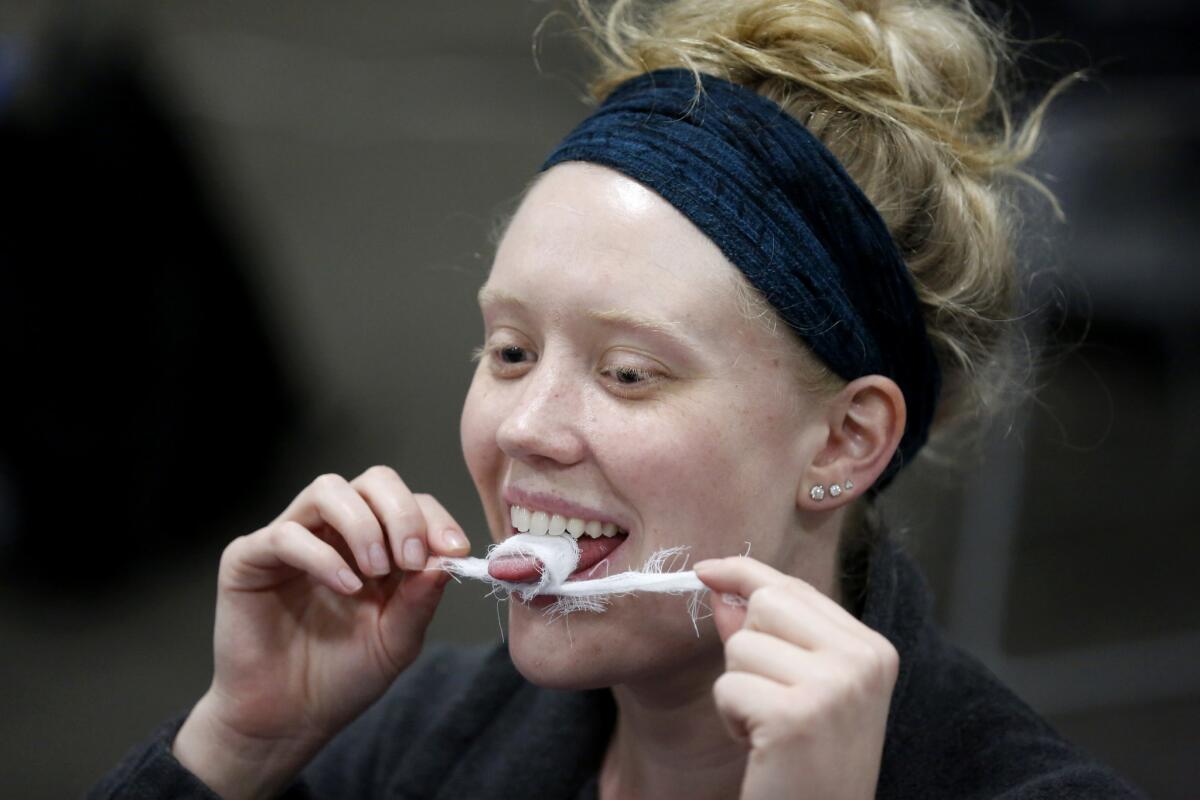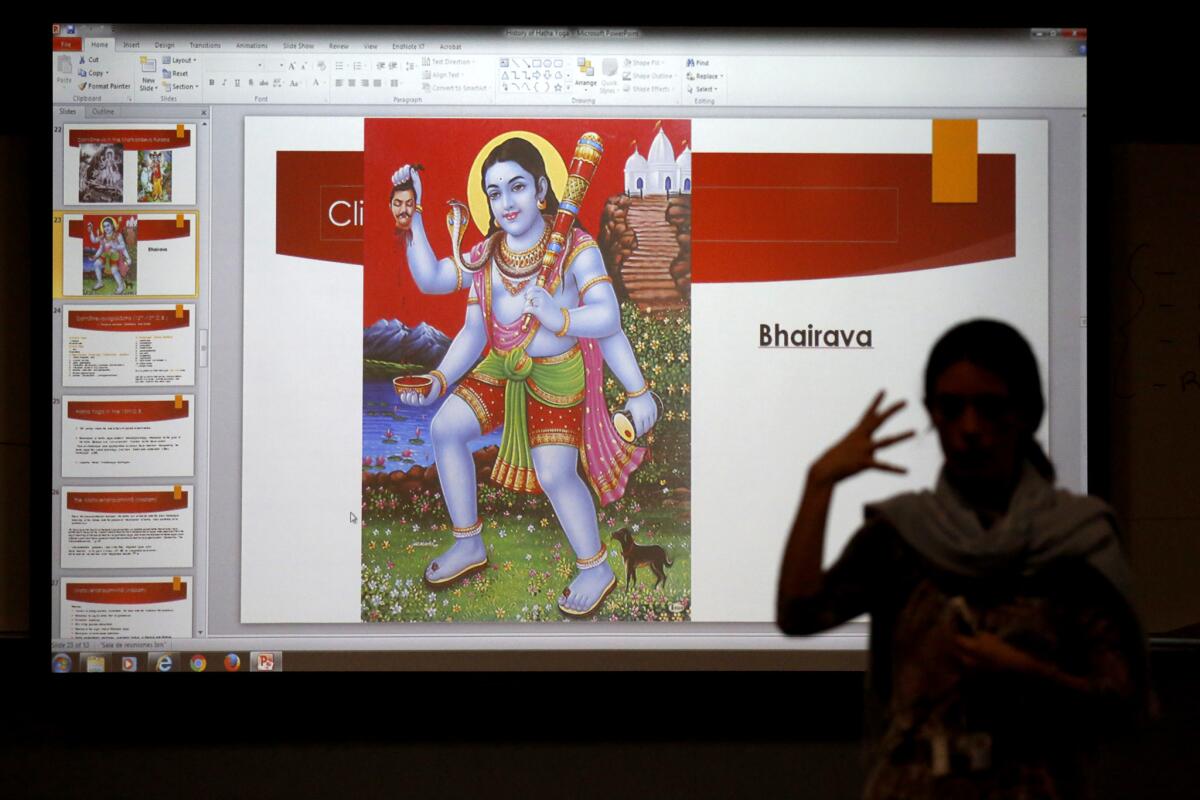The only place in the U.S. you can get a master’s in yoga studies? Los Angeles

Yogis can now obtain a master of arts in yoga studies at Loyola Marymount University.
- Share via
Ana Funes gathered her Westside yoga class in a circle on the floor. She bent her right knee and instructed her students to cradle their own “like a baby.”
But hers wasn’t the “namaste,” downward dog, Lululemon type yoga class as familiar to L.A. as breathing.
Funes is a philosophy professor at Loyola Marymount University. She sat under a whiteboard she’d filled with flow charts and Sanskrit. Her graduate students had just spent more than an hour examining the “Hatha Yoga Pradipika,” a 15th century manual. Now they were eager to understand how the ancient text could be translated into physical experience.
They were studying to earn master’s degrees in yoga studies in the only university in the country where it is possible to do so.
Forty-million people in America say they do yoga — twice as many as five years ago — but how many of them really learn about what it is and where it comes from? It’s an important area of study, says the practice’s few (but growing number of) scholars. After all, Mohandas Gandhi practiced yoga; it is associated with social change, empathy, healing — and is enormously popular.
“I’m personally surprised there aren’t more graduate programs in the study of yoga, given that we're talking about a transnational phenomenon,” said Andrea Jain, co-chair of the Yoga in Theory and Practice unit of the American Academy of Religion, whose members teach religion at schools, seminaries and colleges across the country. “It doesn’t occur to us as scholars to tap into that cultural trend and demand.”
There are a handful of other yoga master’s programs around the world, including one at SOAS University of London (formerly known as the School of Oriental and African Studies), but scholars say LMU’s stands out.
In the LMU program, which enrolled its first students four years ago, the classes are hard, the discussions philosophically complex. Students study Sanskrit grammar, anatomy and history. A few drop out each year when they realize the quantity of reading and writing.


At the Catholic university, it took time to build backing for such a program. When Indic and comparative theology professor Christopher Chapple, who has practiced yoga since he was 15, first pitched the idea two decades ago, many people still thought of yoga as something like a cult or dismissed it as the stuff of suburban housewives.
Chapple had been hired in 1985 to teach all non-Christian religions, in accord with the pope’s proclamation to “recognize, preserve and promote” the good that is found in other traditions. He co-created an Asian studies program, then two theology master’s programs. In 2002, at LMU’s extension school, he introduced a certificate program in yoga therapy, which was so popular that he started five other yoga-focused programs, such as Yoga and the Healing Sciences and Yoga, Mindfulness and Social Change.
Part of Chapple’s argument to LMU was L.A.’s deep connection to yoga — that it was home to some of the first yogis who came to America, that the Westside alone has hundreds of registered instructors certified in its various forms.
“Los Angeles,” he says, “really is a perfect laboratory to teach yoga.”
Yoga shares core values with Buddhism and, like Hinduism, recognizes the Vedas as an authoritative source, Chapple said. But it’s best understood not as a religion but as a system of spiritual practices.
Its origins and history — dating back thousands of years by some measures — are rich and hungry for scholarship. And its disciplines go beyond physical poses (asana) and includes breathing techniques (pranayama), meditation (dhyana) and other activities that connect body and mind. The word itself, yoga, comes from the Sanskrit word yuj, which means to join or apply. Modern practitioners such as B.K.S. Iyengar, T.K.V. Desikachar and Yogi Bhajan, who popularized Kundalini Yoga, spread their own applications and interpretations to thousands.
“It takes someone like Chris to bring the scholarship side and the yoga side together — and keep pushing,” said Andrew Tanner of Yoga Alliance, which oversees the standards of yoga teacher training in America. “The commercialization of yoga sometimes gets in the way of this higher discourse.”
At LMU, studying yoga takes two years and is more in the books than on the mat. Five professors — two full time, three part time — lead about 30 students through numerous disciplines. Students study health sciences. They learn Sanskrit in order to read the “Yoga Sutras,” the “Upanishads,” the “Bhagavad Gita” in their original language. They grapple with Eastern philosophy and numerous Indian theologies.
Julia Kasza, who is heading into her second year, spent four hours a week this year studying Sanskrit grammar and vocabulary for her readings in just one of her classes, then many more hours trying to grasp the philosophies she was reading about.
“All these concepts are so new, I have to read and reread just to be able to talk about it in a way that allows me to produce the kind of thought that’s required to really make sense of it all,” she said after one particularly challenging Sanskrit class. One word, she said, could encompass an entire and many-layered concept.

Kasza and her fellow classmates — who as undergraduates studied religion, social psychology, business, art — come from all over America, as well as Spain, England, China. They have organized yoga training for inmates, taught at transitional living homes and created stress management programs for social workers. One student developed a yoga curriculum for community colleges; another hopes to make yoga part of hospital care.
Many bring what they learn each week into the studio classes they teach around town.
“Let’s warm up the spine,” Rob Zabel, who just graduated this month, told the students in his regular downtown L.A. class as he instructed them to arch their backs while resting on their hands and knees. The sunlit room, tucked inside a converted historic building, filled with purposeful breathing, as if the whole group were trying to fog up a mirror.
He kept his eyes closed as he used what he’d learned in anatomy class to guide his students’ thoughts to the five vertebrae in the lower spine, then the 12 along the ribs and finally the seven leading up the neck. He counted down in Sanskrit, treeni, dve, ekam.
Before coming to LMU, Zabel, a Pitzer College graduate, had completed three yoga teacher training programs. But he wanted more. LMU’s program, he said, allowed him to study yoga — its original texts, forefathers, concepts — objectively as an academic.
“To learn a lot of these things, you basically have to join one of these groups with a lineage and practice it as your religion, or you have these yoga studios where they don’t really want to teach you anything that vaguely comes off as religious and scare you away,” he said. “It’s nice to be able to get an uncensored version of yoga with no agenda.”
After his master’s, Zabel hopes to get a doctorate in history or religious studies. One day, he would love to teach yoga at a university. “It’s important to raise the standard of information,” he said.
Abbie Britton, who got her bachelor’s degree at Barnard, said at first she was embarrassed to tell people the subject of her master’s. But when she talks about her studies at conferences, she said, “everybody gets it.”
"We need a new way of intersecting religion with everyday life,” Britton said one afternoon as she and her classmates gathered on the couches of LMU’s Theology Village. “This idea of scholarship in spiritual traditions, I think, is the future in theology and religious studies.”
A key test for a new degree, however, is whether graduates get jobs or are taken seriously when they apply to doctoral programs.
These days though, more and more religion doctoral students are researching yoga, and as LMU’s program continues to produce graduates, yoga’s academic stature will likely grow, said Jain of the American Academy of Religion, who teaches at Indiana University-
Chapple said he hopes to produce a new generation of thought leaders and yoga scholars, not fitness instructors, who perhaps could go on to become tenured professors.
“Our students — they come from all walks of life, different academic preparations. They’re people in their 20s, 30s, 40s, 50s, 60s, and what they find that they hold in common is this love for learning,” he said. “It’s this love for what’s possible with human thought, and what’s possible in terms of effecting positivity in the world.”
Across town, on the steps of USC’s physical education building, LMU graduate Andre Haralyi sat crossed-legged one afternoon as he thought about his new full-time yoga teaching position at USC.
Eight classes a semester, 240 students, the opportunity to teach a new generation that yoga is about more than just stretching, having a six-pack or wearing the right clothes, he said. There was so much he could share with them from his own experience.
A skateboarding accident 17 years ago had led him to explore the meditative aspects of yoga, which eventually prompted him to leave his home in Brazil to search out other yoga communities. It was at an international yoga conference in India that he first heard of LMU’s program.
“That’s how my journey began, which has brought me here,” he said, as he closed his eyes.
Follow @RosannaXia for more education news
ALSO
This is the year you start mindfulness and yoga practices
Move over, yoga pants. How Kit and Ace created clothes for work — and meditation
Sign up for Essential California
The most important California stories and recommendations in your inbox every morning.
You may occasionally receive promotional content from the Los Angeles Times.








